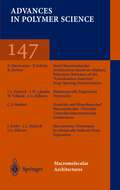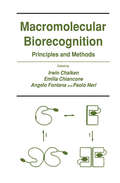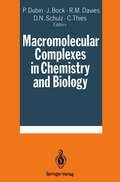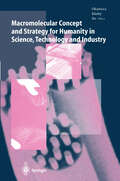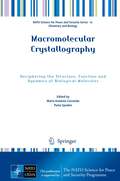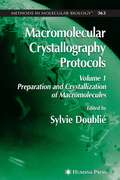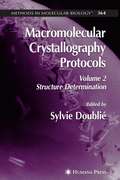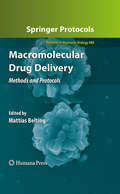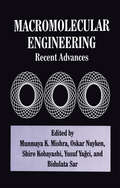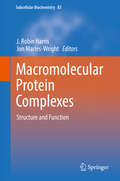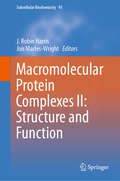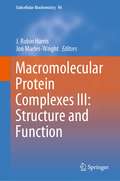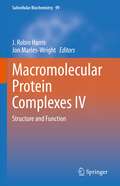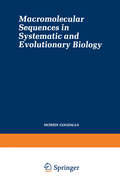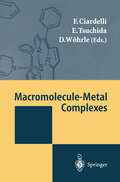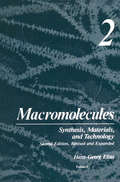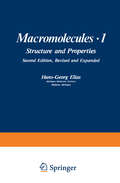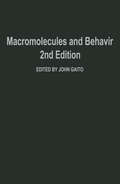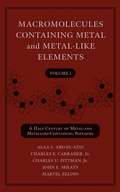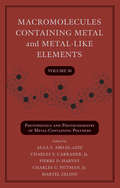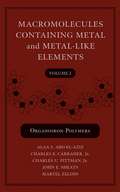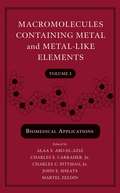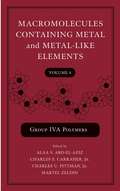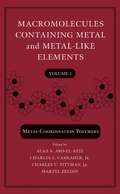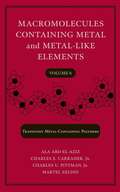- Table View
- List View
Macromolecular Architectures (Advances in Polymer Science #147)
by P. Dubois C. J. Hawker J. L. Hedrick J. G. Hilborn R. Jerome J. Kiefer J. W. Labadie D. Mecerreyes W. VolksenMacromolecular Biorecognition: Principles and Methods (Experimental Biology and Medicine #19)
by Irwin Chaiken Emilia Chiancone Angelo Fontana Paolo NeriMacromolecular Complexes in Chemistry and Biology
by Paul Dubin J. Bock Richie Davis Donald N. Schulz Curt ThiesMacromolecular Concept and Strategy for Humanity in Science, Technology and Industry
by Y. Ito S. Kawabata M. Niwa S. Okamura B. Ranby Y. Sakurada K. Takakura N. YodaNew macromolecular concepts and strategies are demonstrated in this unique book. It deals with the harmonization of humanity in science, technology and industry. Particular attention is given to the relationship between the sensitivity of the human mind and the functionality of polymers such as "Shingosen". Moreover, biocompatibility of functional polymers for medical applications and fabrics is discussed as one of the prime examples of human creativity. Lessons of conventional wisdom of traditional Japanese shrine carpenters, which originated 1300 years ago in Horyuji Temple in Nara Japan, can be applied to modern business management by entrepreneurs and in high-tech industries.
Macromolecular Crystallography: Deciphering the Structure, Function and Dynamics of Biological Molecules (NATO Science for Peace and Security Series A: Chemistry and Biology)
by Maria Armenia Arménia Carrondo and Paola SpadonThis volume is a collection of the contributions presented at the 42nd Erice Crystallographic Course whose main objective was to train the younger generation on advanced methods and techniques for examining structural and dynamic aspects of biological macromolecules. The papers review the techniques used to study protein assemblies and their dynamics, including X-ray diffraction and scattering, electron cryo-electron microscopy, electro nanospray mass spectrometry, NMR, protein docking and molecular dynamics. A key theme throughout the book is the dependence of modern structural science on multiple experimental and computational techniques, and it is the development of these techniques and their integration that will take us forward in the future.
Macromolecular Crystallography Protocols, Volume 1: Preparation and Crystallization of Macromolecules (Methods in Molecular Biology #363)
by Sylvie DoubliéMacromolecular Crystallography Protocols, now in two volumes, examines major developments that have occurred since publication of the acclaimed first edition nearly a decade ago. Volume 1 is composed of detailed protocols for the preparation and optimization of crystals. Volume 2 complements the first volume by addressing laboratory techniques for crystal handling and structural characterization. The volume concludes with a survey of available crystallographic software.
Macromolecular Crystallography Protocols, Volume 2: Structure Determination (Methods in Molecular Biology #364)
by Sylvie DoubliéIn the decade since publication of the first edition this book, the field has seen several major developments. These developments have both accelerated the pace of structure determination and made crystallography accessible to a broader range of investigators. Volume I is dedicated to crystallization and ways to increase the odds of obtaining crystals in macromolecules. Volume 2 covers both computational methods for characterizing crystals and solving structures.
Macromolecular Drug Delivery: Methods and Protocols (Methods in Molecular Biology #480)
by Mattias BeltingMacromolecular drugs hold the promise of becoming new therapeutics for several major disorders, including cancer and cardiovascular disease. This incredible potential is explored in Macromolecular Drug Delivery, a volume which gives a wide-ranging overview of contemporary methods used in the field, and which addresses the limitations presented by a lack of safe and efficient drug delivery strategies. Chapters offer information on both in vitro and in vivo methods of macromolecular delivery, thus appealing to a broad scientific audience. Composed in the highly successful Methods in Molecular Biology™ series format, each chapter contains a brief introduction, step-by-step methods, a list of necessary materials, and a Notes section which shares tips on troubleshooting and avoiding known pitfalls. Comprehensive and cutting-edge, Macromolecular Drug Delivery offers a platform for interdisciplinary collaboration, which should provide opportunities for new discoveries at the interface between disciplines. Ultimately, this cooperation will lead to the use of macromolecular drugs as novel diagnostic tools and, even more importantly, as a means to revolutionize the way we view and treat diseases.
Macromolecular Engineering: Recent Advances
by S. Kobayashi M. K. Mishra O. Nuyken B. Sar Y. YagciThis volume Macromolecular Engineering: Recent Advances has been developed based on the 1 st International Conference on "Advanced Polymers Via Macromolecular Engineering" (APME '95), June 24-29, 1995 at the Vassar College campus, Poughkeepsie, New York. In APME '95, 100 oral and over 50 poster presentations are to be delivered from scientists around the globe. The scientific program covers recent advances in macromolecu lar engineering. It is our vision that the knowledge of the past and the promise of the future are blended together in APME '95 to enrich and stimulate the scientists, which will bring about the progress of macromolecular engineering. Scientists from over 30 countries will be joining together to share this vision. Although over 150 papers are to be presented in APME '95 conference, we could not include all the papers in this book for a variety of reasons, most importantly the authors willingness to contribute to this volume in time to meet the deadline. However, the 24 comprehensive chapters included in this volume are a true reflection of some of the important themes of macromolecular engineering that are part of the APME '95 conference. We believe macromolecular engineering is the key to developing new polymeric materials and, to this end, it is hoped this volume will aid in this introspection.
Macromolecular Protein Complexes: Structure and Function (Subcellular Biochemistry #83)
by J. Robin Harris Jon Marles-WrightThis volume of the established Subcellular Biochemistry series presents 20 chapters dealing with a broad range of interesting protein complexes. It will enable researchers to readily appreciate the major contribution from both X-ray crystallography and cryo-electron microscopy in this field of study. The biological significance of these structural studies is emphasised throughout the book. The diversity of the material included here indicates the breadth of this field and the tremendous progress that has been made in recent years. The book is directed primarily to advanced students and researchers in structural biology, and others in the biochemical sciences. It will be supplemented by other related books within the Subcellular Biochemistry series. One of the Editors (JM-W) is actively involved in structural biology and the other (JRH), as a retired academic and the Series Editor of Subcellular Biochemistry, has long experience at editing multi-author books.
Macromolecular Protein Complexes II: Structure and Function (Subcellular Biochemistry #93)
by J. Robin Harris Jon Marles-WrightThis book follows on from Volume 83 in the SCBI series (“Macromolecular Protein Complexes”), and addresses several important topics (such as the Proteasome, Anaphase Promoting Complex, Ribosome and Apoptosome) that were not previously included, together with a number of additional exciting topics in this rapidly expanding field of study. Although the first SCBI Protein Complex book focused on soluble protein complexes, the second (Vol. 87)addressed Membrane Complexes, and the third (Vol. 88) put the spotlight on Viral Protein and Nucleoprotein Complexes, a number of membrane, virus and even fibrillar protein complexes have been be considered for inclusion in the present book. A further book is also under preparation that follows the same pattern, in an attempt to provide a thorough coverage of the subject.Chapter 9 is available open access under a Creative Commons Attribution 4.0 International License via link.springer.com.
Macromolecular Protein Complexes III: Structure and Function (Subcellular Biochemistry #96)
by J. Robin Harris Jon Marles-WrightThis book covers important topics such as the dynamic structure and function of the 26S proteasome, the DNA replication machine: structure and dynamic function and the structural organization and protein–protein interactions in the human adenovirus capsid, to mention but a few.The 18 chapters included here, written by experts in their specific field, are at the forefront of scientific knowledge. The impressive integration of structural data from X-ray crystallography with that from cryo-electron microscopy is apparent throughout the book. In addition, functional aspects are also given a high priority. Chapter 1 is available open access under a Creative Commons Attribution 4.0 International License via link.springer.com.
Macromolecular Protein Complexes IV: Structure and Function (Subcellular Biochemistry #99)
by J. Robin Harris Jon Marles-WrightThis book covers the latest findings of a wide variety of viral, prokaryotic and eukaryotic macromolecular protein complexes and builds upon the solid macromolecular foundations established by previous volumes of the Subcellular Biochemistry series. Thus, an almost encyclopaedic coverage of the broad field of protein complex structure and function has been established. The 17 interesting chapters included in this book have been organised into four sections: Soluble Protein Complexes, Membrane Protein Complexes, Fibrous Protein Complexes and Viral Protein Complexes. Significant topics present here are: Fatty Acid Synthase, the Fork Protection Complex, Ribonucleotide Reductase, the Kinetochore, G proteins, the FtsEX Complex, the Kainate Receptor, the Photosystem I-antenna, the Mycobacterial Arabinofuranosyltransferases, the the Bacterial Flagellum, the Actomyosin Complex, Motile Cilia, SLS Collagen Polymorphic Structures, and the Reovirus Capsid and Polymerase. Up-dates/expansion of chapter topics present in earlier volumes are now included in chapters here, e.g., those on Ferritin-like proteins and the Multi-tRNA Synthetase. The book is richly illustrated throughout, the result of an impressive integration of structural data from X-ray crystallography and cryo-electron microscopy. The functional aspects of protein-protein interactions are also given a high priority.
Macromolecular Sequences in Systematic and Evolutionary Biology (Monographs in Evolutionary Biology)
by Morris GoodmanMacromolecule-Metal Complexes
by Francesco Ciardelli E. Tsuchida Dieter WöhrleThe first concise overview on the topic, spanning the spectrum from fundamentals to new application areas. The synthesis, kinetics and thermodynamics of these complexes are covered in detail, while much emphasis is placed on special properties such as gas transport, charge transport, catalysis and light-induced processes. Furthermore, the authors treat the actual working areas for new application methods.In all, a very helpful tool for polymer and materials scientists, as well as organic and physical chemists working in these fields.
Macromolecules: Volume 2: Synthesis, Materials, and Technology
by H. G. EliasThe second edition of this textbook is identical with its fourth German edi tion and it thus has the same goals: precise definition of basic phenomena, a broad survey of the whole field, integrated representation of chemistry, physics, and technology, and a balanced treatment of facts and comprehen sion. The book thus intends to bridge the gap between the often oversimpli fied introductory textbooks and the highly specialized texts and monographs that cover only parts of macromolecular science. The text intends to survey the whole field of macromolecular science. Its organization results from the following considerations. The chemical structure of macromolecular compounds should be inde pendent of the method of synthesis, at least in the ideal case. Part I is thus concerned with the chemical and physical structure of polymers. Properties depend on structure. Solution properties are thus discussed in Part II, solid state properties in Part III. There are other reasons for dis cussing properties before synthesis: For example, it is difficult to understand equilibrium polymerization without knowledge of solution thermodynamics, the gel effect without knowledge of the glass transition temperature, etc. Part IV treats the principles of macromolecular syntheses and reactions.
Macromolecules · 1: Volume 1: Structure and Properties
by H. G. EliasThe second edition of this textbook is identical with its fourth German edi tion and it thus has the same goals: precise definition of basic phenomena, a broad survey of the whole field, integrated representation of chemistry, physics, and technology, and a balanced treatment of facts and comprehen sion. The book thus intends to bridge the gap between the often oversimpli fied introductory textbooks and the highly specialized texts and monographs that cover only parts of macromolecular science. The text intends to survey the whole field of macromolecular science. Its organization results from the following considerations. The chemical structure of macromolecular compounds should be inde pendent of the method of synthesis, at least in the ideal case. Part I is thus concerned with the chemical and physical structure of polymers. Properties depend on structure. Solution properties are thus discussed in Part 11, solid state properties in Part Ill. There are other reasons for dis cussing properties before synthesis: For example, it is difficult to understand equilibrium polymerization without knowledge of solution thermodynamics, the gel effect without knowledge of the glass transition temperature, etc. Part IV treats the principles of macromolecular syntheses and reactions.
Macromolecules Containing Metal and Metal-Like Elements, Volume 1: A Half-Century of Metal- and Metalloid-Containing Polymers (Macromolecules Containing Metal and Metal-like Elements #15)
by Charles E. Carraher Charles U. Pittman John E. Sheats Martel Zeldin Alaa S. Abd-El-AzizMetal- and metalloid-containing macromolecules are defined as large molecules (i.e., polymers, DNA, proteins) that contain a metal or metalloid group affiliated with the molecule. The first volume in this series consists of a number of reviews of the field, to give the reader a background to build upon. Compiled by an all-star cast of macromolecular experts, this guide: Provides useful descriptions of applications for the reader to apply in his/her research into materials, polymers, and medicine/drug development. Covers non-linear optical materials, speciality magnetic materials, liquid crystals, anticancer and antiviral drugs, treatment of arthritis, antibacterial drugs, antifouling materials, treatment of certain vitamin deficiencies, electrical conductors and semiconductors, piezoelectronic materials, electrodes, UV absorption applications, super-strength materials, special lubricants and gaskets, selective catalytic and multisite catalytic agents.
Macromolecules Containing Metal and Metal-Like Elements, Volume 10: Photophysics and Photochemistry of Metal-Containing Polymers (Macromolecules Containing Metal and Metal-like Elements #10)
by Alaa S. Abd-El-Aziz Pierre D. Harvey Martel Zeldin Charles E. Carraher Charles U. PittmanMetal- and metalloid-containing macromolecules are defined as large molecules (i.e., polymers, DNA, proteins) that contain a metal or metalloid group affiliated with the molecule. This volume describes what is possible with metal-containing polymers where the metal is an essential ingredient in obtaining desired optical and electronic properties. Covering applications in nonlinear optical materials, solar cells, light-emitting diodes, photovoltaic cells, field-effect transistors, chemosensing devices, and biosensing devices, this indispensible guide focuses on the photochemistry and photophysics of metal-containing polymers, with chapters by leading contributors to the core advances in this field.
Macromolecules Containing Metal and Metal-Like Elements, Volume 2: Organoiron Polymers (Macromolecules Containing Metal and Metal-like Elements #19)
by Alaa S. Abd-El-Aziz Charles U. Pittman John E. Sheats Martel Zeldin Charles E. CarraherMetal- and metalloid-containing macromolecules are defined as large molecules (i.e., polymers, DNA, proteins) that contain a metal or metalloid group affiliated with the molecule. Compiled by an all-star cast of macromolecular experts, Macromolecules Containing Metal and Metal-Like Elements, Volume 2, Organoiron-Containing Polymers: Provides useful descriptions of applications for the reader to apply in his/her research into materials, polymers, and medicine/drug development. Covers non-linear optical materials, speciality magnetic materials, liquid crystals, anticancer and antiviral drugs, treatment of arthritis, antibacterial drugs, antifouling materials, treatment of certain vitamin deficiencies, electrical conductors and semiconductors, piezoelectronic materials, electrodes, UV absorption applications, super-strength materials, special lubricants and gaskets, selective catalytic and multisite catalytic agents.
Macromolecules Containing Metal and Metal-Like Elements, Volume 3: Biomedical Applications (Macromolecules Containing Metal and Metal-like Elements #3)
by Alaa S. Abd-El-Aziz John E. Sheats Martel Zeldin Charles E. Carraher Charles U. PittmanMetal and metalloid-containing compounds exhibit a wide range of biological and biocidal activities, some of which have been employed in medicines and drugs. Polymers containing metal or metalloid functions become a natural extension of this effort; just as organic compound drugs have been chemically bound to polymers or physically imbibed into polymer matrices in order to provide a variety of useful advantages, the same opportunities exist for using metal and metalloid species. This volume will cover important biomedical applications of organometallic compounds, including metal-labeled DNA on surfaces, artificial metallo-DNA, organotin molecules as anti-cancer drugs, and much more. * Provides useful descriptions of biomedical applications for the reader to apply in his/her research into materials, polymers, and medicine/drug development. * Edited by high-quality team of macromolecular experts from around the world
Macromolecules Containing Metal and Metal-Like Elements, Volume 4: Group IVA Polymers (Macromolecules Containing Metal and Metal-like Elements #13)
by Martel Zeldin Alaa S. Abd-El-Aziz Charles E. Carraher Charles U. PittmanThis series provides a useful, applications-oriented forum for the next generation of macromolecules and materials. Volume 4 provides useful descriptions of Group IV metals and their applications, including silicon-, organogermanium-, organotin-, and organolead-containing polymers. A high-quality team of macromolecular experts from around the world have put together these leading macromolecule titles.
Macromolecules Containing Metal and Metal-Like Elements, Volume 5: Metal-Coordination Polymers (Macromolecules Containing Metal and Metal-like Elements #17)
by Martel Zeldin Alaa S. Abd-El-Aziz Charles E. Carraher Charles U. PittmanThis series provides a useful, applications-oriented forum for the next generation of macromolecules and materials. The fifth volume in this series provides useful descriptions of the transition metals and their applications. Transition Metals are covered in 2 volumes, the second part is covered in Volume 6.
Macromolecules Containing Metal and Metal-Like Elements, Volume 6: Transition Metal-Containing Polymers (Macromolecules Containing Metal and Metal-like Elements #6)
by Martel Zeldin Charles E. Carraher Charles U. Pittman Alaa S. Abd-El-AzizThis series provides a useful, applications-oriented forum for the next generation of macromolecules and materials. The sixth volume in this series provides useful descriptions of the transition metals and their applications, edited by high-quality team of macromolecular experts from around the world.
